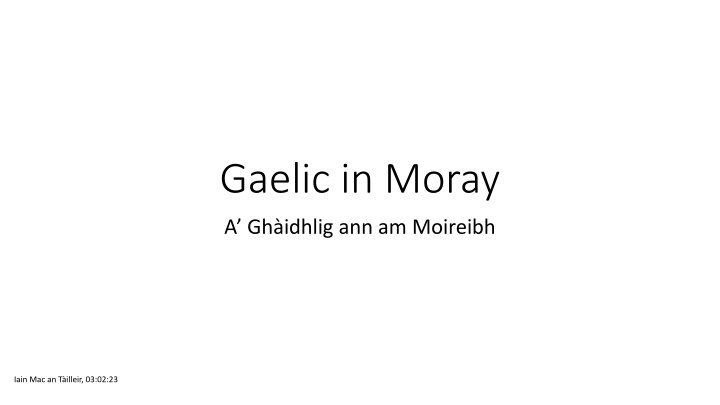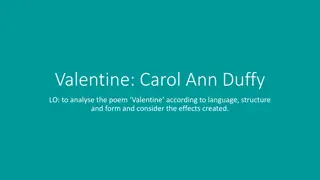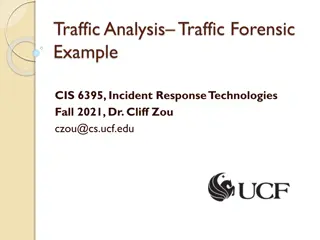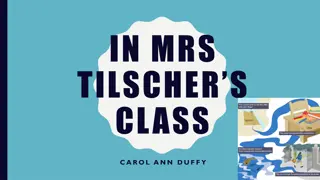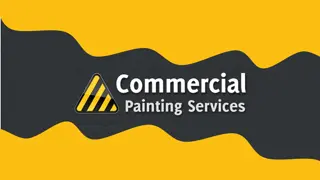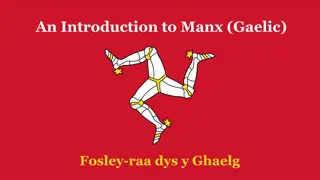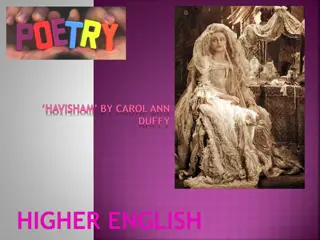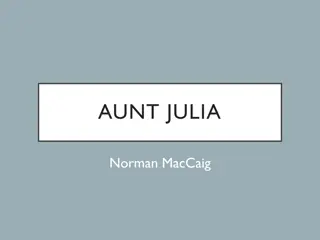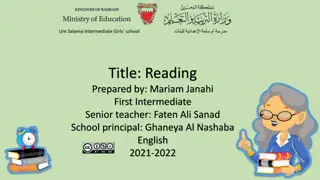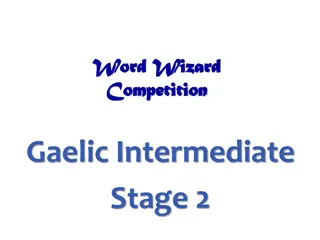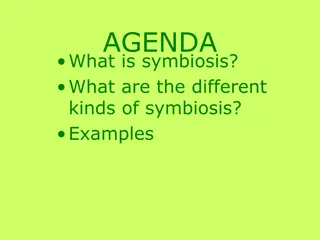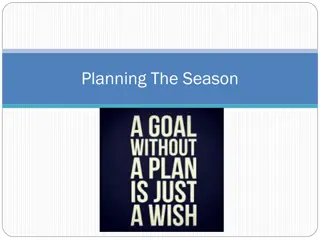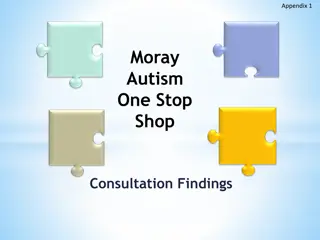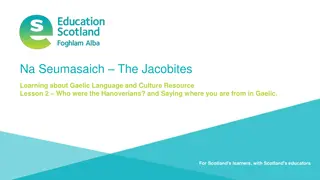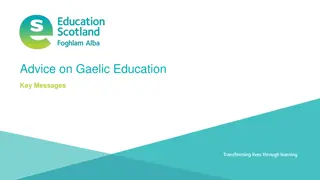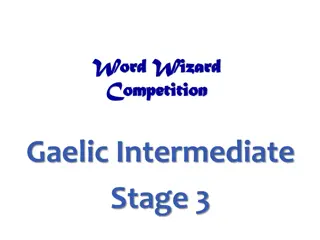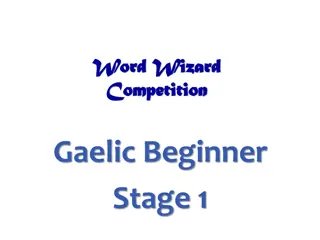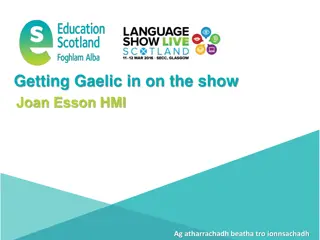Gaelic in Moray. A’Ghàidhlig ann am Moireibh.
Explore the rich history of Gaelic language in Moray, Scotland, spanning from ancient origins to its presence in the 17th and 18th centuries. Discover the impact of Gaelic in various parishes and its evolution through the 19th century with insights from historical accounts and local informants. Uncover the resilience and cultural significance of Gaelic in the region.
Download Presentation

Please find below an Image/Link to download the presentation.
The content on the website is provided AS IS for your information and personal use only. It may not be sold, licensed, or shared on other websites without obtaining consent from the author.If you encounter any issues during the download, it is possible that the publisher has removed the file from their server.
You are allowed to download the files provided on this website for personal or commercial use, subject to the condition that they are used lawfully. All files are the property of their respective owners.
The content on the website is provided AS IS for your information and personal use only. It may not be sold, licensed, or shared on other websites without obtaining consent from the author.
E N D
Presentation Transcript
Gaelic in Moray A Gh idhlig ann am Moireibh Iain Mac an T illeir, 03:02:23
Filte do Mhoireibh Welcome to Moray
Gaelic in Scotland - Spoken in Argyll since around 450 AD but! - Scots and Picts united by around 850 AD. - Scots in charge of Strathclyde by 945 AD. - Alba/Scotland s boundaries settled by 1006. - Gaelic at its peak around 1050-1100
Gaelic in Moray: 17th and 18th centuries - Gaelic in retreat from 12th century in burghs but still the norm outside. - By 17th century Gaelic mainly restricted to upland areas. - In Moray Council Area the following parishes were wholly Gaelic-speaking in 1689: Knockando Edinkillie Inveravon Kirkmichael - Also, Gaelic-speaking communities in: Rothes Mortlach Aberlour Cabrach Dallas - Confirmed in Old Statistical Account from 1790s.
Aberlour Edinkillie Cabrach Knockando Dallas Inveravon Mortlach Kirkmichael Rothes Gaelic-speaking in 1689 Partially Gaelic in 1689
Gaelic in Moray: 19th century Three important sources of information about Gaelic in Moray: - New Statistical Account from 1830s-40s - Ordnance Survey Name Books from 1860s-70s - Census 1891
New Statistical Account, 1830s-40s Church of Scotland ministers wrote descriptions of their parishes. Gaelic speakers in the Moray parishes of: Aberlour Dallas Edinkillie Inveravon Kirkmichael Knockando Mortlach No mention of: Cabrach Rothes
Ordnance Survey Name Books Gaelic placenames in Gaelic spelling Placenames recorded from reliable local informants in 1860s-70s. Gaelic spelling: Slag nam Meann. English/Scots spelling: Slock na Myawn. Evidence for or against a residual presence of Gaelic. Why does this matter? On 15thFebruary 1976, A Watson, J Duff and Betty Allan visited her [Mrs Bain s] son Robert near Crathie, as someone had told us that he would probably know some local place names. Mrs Bain repeated Robert s names in a pronunciation different from anything we had heard from numerous informants in Upper Deeside. With growing astonishment we listened, realising that Braemar Gaelic had not died after all. [Watson, A & Clement, R D (1983) Aberdeenshire Gaelic. Inverness: TGSI. Vol. LII: 387] [Slock na Myawn] A small but conspicuous hollow a short distance south of Clashconnachie farmsteading. Although this name is well known, no person in the district can give its derivation. [https://scotlandsplaces.gov.uk/digital-volumes/ordnance-survey-name-books/morayshire-os-name-books- 1868-1871/morayshire-volume-07/62] [accessed 29:12:22]
Ordnance Survey Name Books 607 names collected in Gaelic spelling Aberlour 8 names mainly Glenrinnes Birnie 1 name at Glenlatterach Boharm 5 names near Mulben Botriphnie 1 name near Drummuir Cabrach 53 names throughout the area Dallas 12 names mainly south of the village Edinkillie 39 names throughout the area Elgin 1 name north of the Buinach Inveravon 53 names throughout the area Kirkmichael 380 names throughout the area Knockando 35 names throughout the area Mortlach 15 names around Dufftown Rathven 1 name in the Braes of Enzie Rothes 3 names around the town St Andrews-Lhanbryde 1 name near Orton 1 1 1 1 3 12 5 39 1 35 15 8 53 53 380
Moray placenames - examples Examples of names recorded by OS in Gaelic spelling Rothes Allt Clachan B n Stream on north shoulder of Ben Aigen opposite Dundurcas. Starts in Boharm. Burn of light-coloured stones . 21 Caochan Dubh Stream rising in Mannoch Moss and flowing east into Cach na Vattie. Starts in Knockando. Black streamlet . 22-102 Tobar D mhnaich A spring formerly a resort of pleasure parties then cased in and the waters conveyed to Glengrant house for domestic use. It is traditionally recorded to have possessed rare medicinal qualities and is regarded as a holy well. "Lord's well". 18-99 St Andrews (centred on Lhanbryde) Volume 21 Loch na B Loch nam B Loch and settlement south-east of Lhanbryde. "Loch of the cows". 54 Examples of Gaelic names in English/Scots spelling Aberlour, Obar Lobhair. "The mouth of the noisy or talkative stream". Aberlour Church and Parish respectively are Cill Drostain and Sg re Dhrostain, "the church/parish of St Drostan". The town is officially known as Charlestown of Aberlour in memory of the founder of the planned village, Charles Grant of Elchies. Achbreck, An t-Achadh Breac. The speckled field".
Census 1891 Gaelic-speaking ability in north-east Blue shows parishes containing Gaelic- majority communities: Gaulrigg 71% * * Tomdow 54% They include places where over 20% of people spoke Gaelic: * * * Braemoray & Dava 48% Strathavon 35% Tomintoul 24%
In our own times The Survey of the Gaelic Dialects of Scotland recorded local native speakers from Moray in the 1950s, so we have examples of Moray Gaelic. Moray people have contributed to Gaelic culture, literature and scholarship. But there are still people who honestly believe Gaelic was never spoken in Moray. As there are in Caithness Caithness is one of those privileged areas of Scotland where the inhabitants can boast of a share in both of Scotland's languages and cultures: the marvellous riches both of English or Scots on the one hand, and of Scottish Gaelic on the other. The recent decisions to open a Gaelic-medium unit in Thurso, and to put Gaelic place-names on some road signs in the county, are surely developments which should be welcomed by all who care about the fascinating history and cultures of Caithness. Gaelic is a hidden heritage belonging to all the people of the county. Life is more interesting with it than without it. [Sti bhart, D U (2008). Gallaibh nan G idheal s nan Gall. Caithness of the Gael and the Lowlander . Am Bratach 200]
Gaelic is all around us an inscription from Burghead (thanks to Karen) Bithibh fialaidh ri coigrich
References Diack, F C (1944). The Inscriptions of Pictland. Aberdeen: Third Spalding Club Grannd, P (1823). D in Spioradail. Inverness: J Johnstone Grant, J (2003). The Gaelic of Strathspey and Its Relationship to Other Dialects . TGSI LXI, 71-116 Inverness: Gaelic Society of Inverness Grant, S (2002). Gaelic in Western Banffshire . Rannsachadh na G idhlig 2000. Aberdeen: An Cl Gaidhealach Dochartaigh, C (ed.) (1997). Survey of the Gaelic Dialects of Scotland, Vols 1-5. Dublin: Dublin Institute for Advanced Studies Sti bhart, D U (2008). Gallaibh nan G idheal s nan Gall. Caithness of the Gael and the Lowlander . Am Bratach 200 Taylor, I (2022). The Placenames of Scotland. Edinburgh: Birlinn Watson, A & Clement, R D (1983) Aberdeenshire Gaelic . TGSI LII, 373-404. Inverness: Gaelic Society of Inverness Withers, C (1984) Gaelic in Scotland 1698-1981. Edinburgh: John Donald Duwe, K (2006-2022). http://www.linguae-celticae.org/GLP_english.htm# [accessed 05:12:22] Gaelic Place-names of Scotland. https://www.ainmean-aite.scot/ [accessed 20:12:22] Ordnance Survey Name Books. https://scotlandsplaces.gov.uk/digital-volumes/ordnance-survey-name-books [accessed 29:12:22]
